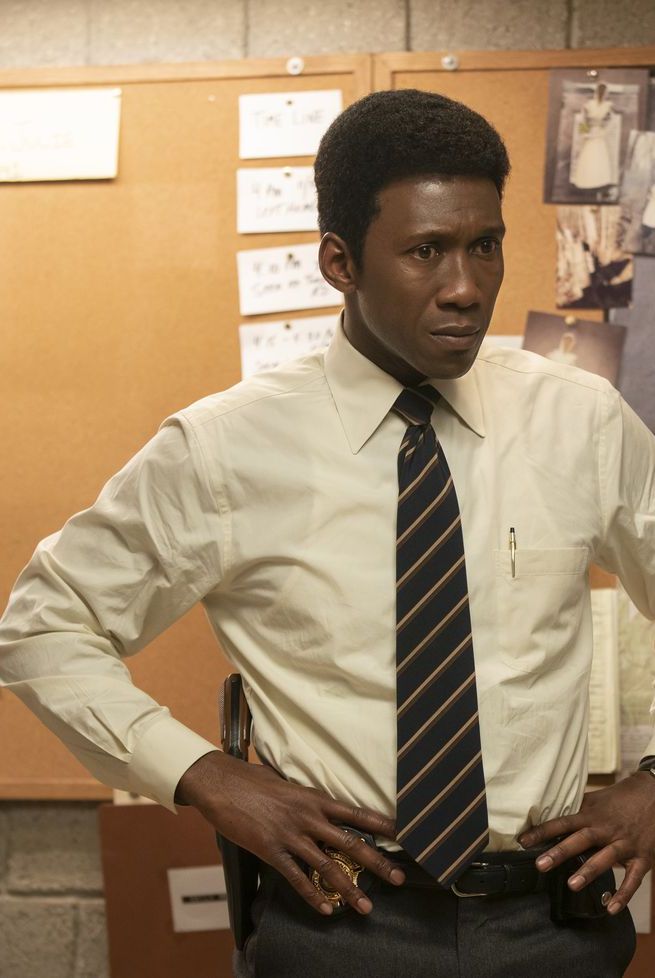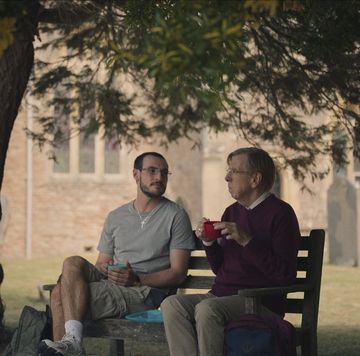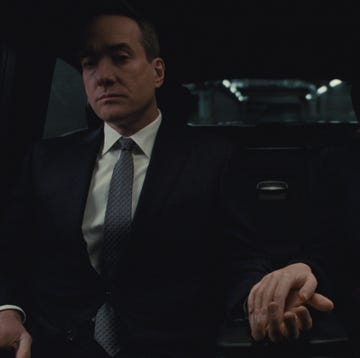The second episode of True Detective's third season sees some small steps forward and large jumps backward in the 1980 Purcell case. Hays begins to narrow down the meaning behind the dolls found left behind at Devil's Den, where the boy was found dead. But the feds are simultaneously inhibiting the investigation by publicly releasing key breaks in the case. The biggest clue in this second episode, however, might have nothing to do with this season of True Detective at all—it's a subtle nod to the case back in Season One.
In one 2015 scene, documentary producer Elisa Montgomery is showing 70-year-old Hays some online forums that are investigating the Purcell case. She asks him:
Did you know at various times since large-scale pedophile rings connected to people of influence were uncovered in the surrounding areas? Did you know about the Franklin scandal? It's been theorized that the straw dolls are a sign of pedophile groups like the Crooked Spiral.
What she's referring to is the symbol seen throughout True Detective Season One, found, most notably, carved on the back of Dora Lange's body and seen in some of Rust Cohle's visions. Obviously, Redditors—who have followed the previous two seasons of this show like it's an actual crime to solve—noticed this subtle reference. But does it mean anything? In an interview with The Hollywood Reporter, executive producer Scott Stephens said this doesn't necessarily mean that the two seasons are intertwined:
"I guess it's set in the same fictional world everything is set in, right? The reference is kind of a nod to the [first season]. The stuff in season one was based on the same sort of pedophilia stories that are mentioned by the documentary crew. That's kind of the connective tissue."
In other words, it seems like this Crooked Spiral reference is just a fun way to fuck with devoted fans. But on a deeper level, it notes the danger of amateur sleuths and conspiracy theories in general. In the same sentence, Montgomery also references the Franklin scandal, which was an elaborate conspiracy theory accusing prominent Americans of being involved in a massive child prostitution ring. These conspiracy theories were later concluded to be an intricate hoax by separate grand juries. The Franklin scandal has also become a case study of sorts for how conspiracies can get conflated with truth and be given credibility by news organizations that report on them. In a time of Pizzagate and Qanon, this is an important thing worth noting. But it's also something to be said of True Detective itself, which is the subject of many theories—specifically on Reddit. Already fans are debating whether the Yellow King has something to do with the kidnapping of the Purcell children. And, it's admittedly pretty funny that Stephens put to rest those theories before they could even get started.
If the Crooked Spiral reference is a small red herring, what could that mean for everything else we've seen in the first two episodes of this season? Is it possible that the dolls themselves—which Montgomery notes resemble the Yellow King murders—are a red herring on their own? How about the peep hole carved into the closet of Will's room? This episode also sees Hays question the Purcell kid's uncle, who was staying in the room and left behind porno magazines and presumably drilled the hole in the wall. Is it possible that this disturbing clue is unrelated to the missing child?
As a whole, Episode Two asks fans to question the legitimacy of all the evidence at hand. Hays is worried that the feds are showing their hand too early by sharing the development of the doll with the public. Evidence, clues, connections—they're all not created equal and are only valuable when handled properly. In other words, Episode Two warns fans to tread carefully and beware of confusing a theory with fact. Take note, Reddit.
Matt Miller is a Brooklyn-based culture/lifestyle writer and music critic whose work has appeared in Esquire, Forbes, The Denver Post, and documentaries.













